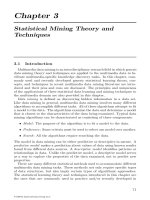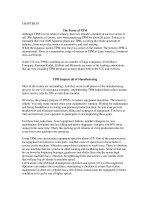Tài liệu Measuring customer satisfaction 3 pdf
Bạn đang xem bản rút gọn của tài liệu. Xem và tải ngay bản đầy đủ của tài liệu tại đây (222.89 KB, 25 trang )
Measuring Customer
Satisfaction
Nancy Levin
Director – Quality Assurance
2
Customer Satisfaction: Critical Findings
• 100 satisfied customers generate 25 new customers.
• For every 1 customer complaint received, 20 other
dissatisfied customers do not bother to complain.
• Cost of acquiring 1 new customer is 5 times as great as
the cost of retaining a satisfied customer.
• Customer satisfaction is integral to TQM by establishing
Expectations
Standards
Performance requirements
3
Customer Satisfaction: Measurement Objectives
• Determine which customers to survey
• Determine critical performance attributes that result in
customer satisfaction
• Assess company performance
• Establish corrective action
• Monitor continuous improvement
4
Surveying – Who Are Your Customers?
• External customers
Buying Influence
Supervisors
“Bill To” Contact
• Internal customers
HQ/Field management
Staff
Inter/Intra departmental teams
5
Determining Critical Performance Attributes
• What attributes generate satisfied and dissatisfied
customers? ASK
• Determined through:
Qualitative research techniques
•
Discussion groups/in-depth interviewing
•
Conduct research
•
Use customer vocabulary/terminology when developing
preliminary performance attributes
Quantitative research techniques
•
Use information from qualitative research
•
Develop survey tool
•
Conduct research
•
Establish critical performance attributes
6
Universal Performance Attributes
• Related to the product
Value/price relationship
Quality
Features
Product design
Range of products & services
Reliability and consistency
• Related to service
Warranty
Delivery
Complaint resolution
7
Universal Performance Attributes
• Related to purchase
Communication
Courtesy
Convenience
Reputation
Competence
8
Voice of Experience - Determining Critical
Performance Attributes
• What do customer’s want from a supplemental staffing
company?
Speed of response
Accuracy of the match
Invoice accuracy
Innovativeness
Ability to resolve problems
React with a sense of urgency
• What do temporary employees want?
To be consistently working
Receive accurate paychecks
Pay reflects performance
Receive performance feedback
Be treated with respect
9
Type of Survey: Mail – Electronic - Telephone
• Telephone
Requires maintenance of accurate telephone numbers
Customer skepticism/reluctance to respond
Higher response rate than mailed survey
Cost in time/labor
Requires maintenance of accurate addresses
Highest cost in labor and materials
Lowest response rate
• Electronic
Requires maintenance of accurate e-mail addresses
Most cost effective
Highest response rate
10
Type of Survey - Voice of Experience
• Local
Electronic surveys
Direct Time (automated time submittal/approval)
• National third-party studies
Customer – Telephone survey
Employee – Mailed survey









